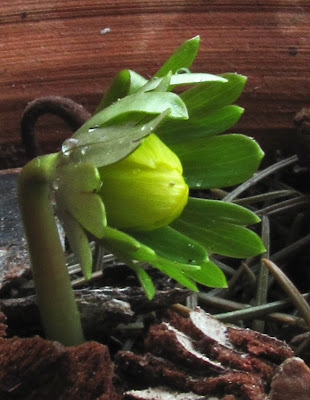I have a lot to tell but at this time of year let's begin with the most important – at least for me: the first Eranthis hyemalis flower opened yesterday on our balcony. I realized the little yellow spot only after some lingering around that pot!
So I decided to cut down the dried leaves of the Campanula raddeana. They were left for winter to protect the sleeping buds of Hepatica nobilis (and also of different bulbs resting in that pot):
 |
| Buds of Hepatica nobilis |
Here is after the haircut (picture taken yesterday afternoon with flash):
The long ribbons are the leaves of autumn flowering Sternbergia lutea.
Today was sunny and warm (14°C), so the Eranthis flower opened. It is obvious from the following picture how much it resembles to the
hellebore flower.
Both have the petals transformed to nectaries, and the sepals taking the role of the petals. Both have many anthers, of the same shape. But the hellebores have 5 sepals which remain on the flower after flowering, the Winter Aconite (Eranthis) has more sepals which fall down after pollination. And the Eranthis has those pretty bracts looking like collars around the flower.
Both belong to the Helleboraceae family. As I know they were the same genus (Helleborus) some time ago. Winter Aconite is also called Winter Hellebore.
I observed in the sunshine that the Caryopteris has already little new leaves:
 |
| Caryopteris x clandonensis 'Heavenly Blue' |
I got it last autumn and I wondered if it would be hardy in a pot. It seems like it was. I have to cut it down soon, and also to put it in a larger pot.
________________________________________________________________________________
Seed sowing
Yesterday I sowed the seeds got from the
SRGC. I got the packet in middle January but I simply did not feel like to sow them (it happens sometimes to me!). So I put them in moist vermiculite in zip lock bags, than in paper bags and put outside on the frosty balcony.
I like vermiculite for seed storing and layering. I've heard that it was good also for the ephemeral seeds to preserve germinating capacity.
I used to pour it dry in the bag, then put the seeds, mix it, and then spray into the bag 3 times with water, the mix to be just moist. Then lock the bag and put it in the fridge or outside.
When sowing, I pour all the contents of the bag on the moist composts' surface, than cover it with some grit.
Here is yesterdays' sowing:
They go to the garden to be subjected to the whimsy weather. (Don't forget: these are alpine plants' seeds, not tropicals or vegetables!)
There are also some bulbous plants' seeds, like Crocus banaticus, Scilla greilhuberi, Merendera montana, Fritillaria sp. and Allium sp. collected in Asia, which are in water now to soak. They will be sown tomorrow.
________________________________________________________________________________
Bulb blue
I have to turn again to the recently shown forced bulbs. There was a narcissus bulb which
has very few roots. Well, it made only one flower and the leaves remained small. Now the tips of the leaves are yellow/brown:
I learned from
Ian Young that this meant the bulb was beginning to rot.
I pulled it out easily from the compost because those few roots are almost all gone:
Cutting the bulb in two, can be seen the spots where the rot begun:
It's fantastic that you can see this on the leaves!
The forecast says that winter comes back by the end of February, but today I gave some water to our miniature alpine gardens. If the alpines feel that winter is over, they begin to assimilate and need water for that. If the weather is not favourable, they just stop growing but don't die, because the sap is already moving in their body, and the new season's life is irreversible.
Welcome, new season's life!































